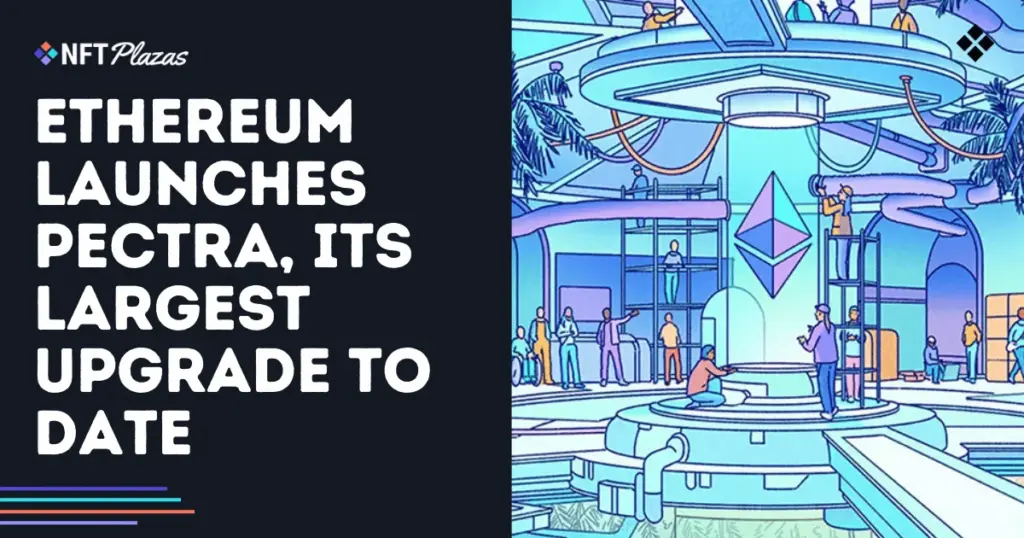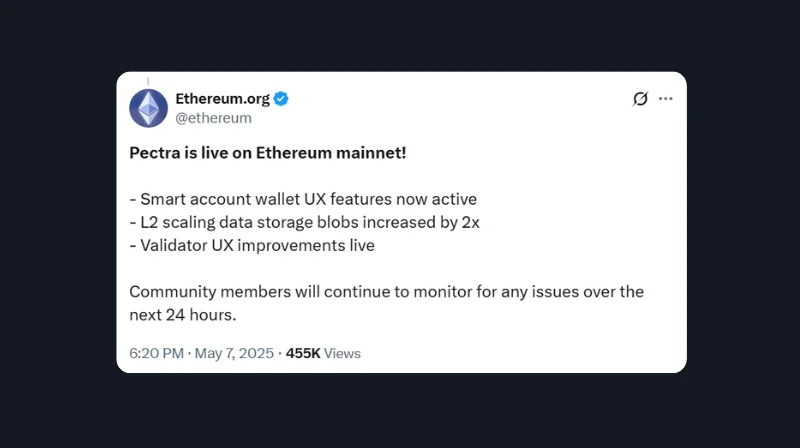
Ethereum has completed the first phase of a major software upgrade called Pectra, marking a significant change to how the network handles accounts, staking, and data processing.
The rollout comes over a year after Ethereum’s previous major update—known as Dencun—and continues the project’s shift toward improving how the blockchain scales and operates under increased demand. Pectra introduces a range of Ethereum Improvement Proposals (EIPs), including changes to how wallets function, how validators manage their stake, and how data is processed through the network.
Whilst the upgrade is largely technical, it is expected to affect a wide range of users and developers, especially those working on Layer 2 networks and decentralised applications.

 Source: Ethereum
Source: EthereumWhat is Pectra?
Pectra is the name given to Ethereum’s latest hard fork—a coordinated protocol update that modifies the network’s rules. The upgrade was activated on Wednesday at 06:05 ET, with network finality confirmed shortly after at 06:18 ET.
It follows the Dencun upgrade of March 2024 and represents Ethereum’s next step in improving its infrastructure for both users and developers.
The name combines “Prague” and “Electra”, referring to future roadmap goals involving both the consensus and execution layers of the network.

 Source: Ethereum
Source: EthereumWhat’s new with this upgrade?
Pectra includes several key changes:
- Account Functionality: The update introduces EIP-7702, which allows standard user accounts to temporarily behave like smart contracts. This gives accounts more flexibility without requiring users to switch to a new address format. It is considered an early step toward full “account abstraction,” a long-term goal that would allow more programmable and user-friendly wallets.
- Validator Staking: EIP-7251 increases the maximum stake per validator from 32 ETH to 2,048 ETH. This is intended to reduce operational overhead for large validators and allow them to consolidate multiple positions into fewer, larger ones. It may also improve staking efficiency.
- Data Availability: EIP-7691 increases the number of “blobs”—a type of off-chain data package introduced in Dencun—from 3 to 6 per block. Blobs are used primarily by Layer 2 scaling solutions to lower transaction fees. The change effectively increases Ethereum’s data capacity for such networks.
- Other Improvements: The upgrade also includes optimisations for validator deposit handling, historical data access, cryptographic operations, and execution-layer exits.
Each of these features was proposed, tested, and reviewed before being included in the upgrade.

 Source: Ethereum
Source: EthereumWhat’s next for Ethereum?
Developers are now shifting their attention to the next planned upgrade, known as Fusaka. Among its goals is expanding data availability further, including support for a feature called PeerDAS—a protocol designed to improve how rollups access and distribute data.
Although Pectra increases blob capacity, developers say additional scaling improvements will be needed to keep pace with Layer 2 growth. Some believe Ethereum’s data layer will require even larger increases in capacity to avoid congestion over time.
In the meantime, Ethereum validators may need to manage higher bandwidth and storage demands as part of the trade-off for greater throughput. According to researchers, ensuring that the network remains decentralised whilst increasing performance will continue to be a major area of focus.
Fusaka is expected to address some of these concerns, though no official timeline for its deployment has been announced.






